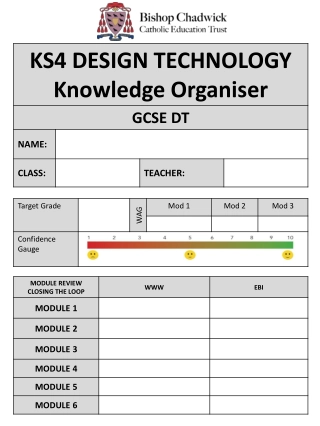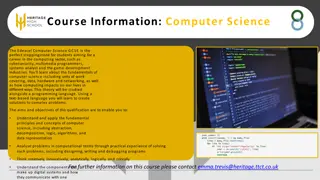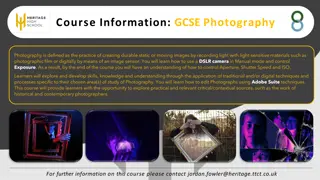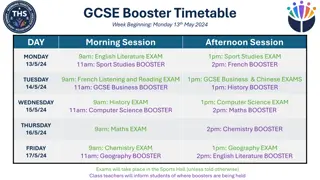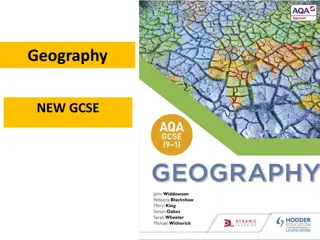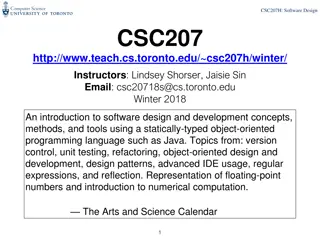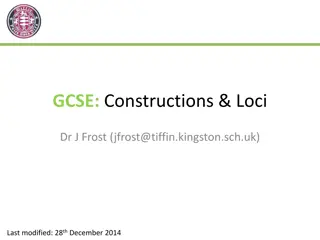Overview of Design & Technology GCSE Course
Design & Technology GCSE (9-1) with OCR exam board introduced in 2017 focuses on improving everyday living through product design. The course involves creative thinking, refining ideas, manufacturing, communication skills, decision-making, and safe practices in design. Assessment includes a written paper and an iterative design challenge project to assess learners' understanding and application of design principles.
Download Presentation

Please find below an Image/Link to download the presentation.
The content on the website is provided AS IS for your information and personal use only. It may not be sold, licensed, or shared on other websites without obtaining consent from the author.If you encounter any issues during the download, it is possible that the publisher has removed the file from their server.
You are allowed to download the files provided on this website for personal or commercial use, subject to the condition that they are used lawfully. All files are the property of their respective owners.
The content on the website is provided AS IS for your information and personal use only. It may not be sold, licensed, or shared on other websites without obtaining consent from the author.
E N D
Presentation Transcript
Welcome to the Design and technology GCSE (9-1) Introduced in 2017 OCR exam board for this subject
What is design and technology? We are a subject that look at different ways to improve everyday living through product design.
Why choose Design and Technology? D&T allows us to think creatively, identify and develop ideas with clear initiatives and objectives using a range of materials and equipment. D&T is a dynamic and continually evolving subject, making it exciting and engaging. The subject provides a platform for those wanting to explore D&T in further education, for example A levels, BTEC diplomas, HND s, apprenticeships and future careers within the field of design.
What does it involve? Observe real-life design case studies Learn and understand the importance of the design process Encourage creative thinking, experimenting and risk taking in order to maximise design proposals Learning how to refine ideas Understanding manufacturing and engineering Learning how to communicate your ideas and decision making to an audience Developing decision making skills, including careful planning, time management and meeting deadlines Consider costing, commercial viability and marketing of products Demonstrate safe working practices in design and technology Learning how to develop realistic design proposals as a result
How is the course assessed? Principles of design and technology 100marks 2 hour written paper and is split into two sections Demonstrates learners broad understanding of principles that all learners should have across the subject Core knowledge 50% of total GCSE (9-1) Allows learners to focus more directly on at least one main material category, or design engineering. In-depth knowledge A minimum of 15% of the paper will assess learners mathematical skills as applied within a design and technology context
How is the course assessed? Iterative design challenge project 100 marks Approximately 40 hours Non-exam assessment 1. 2. Create solutions that meet those needs (Create) 3. Evaluating whether those needs have been met (Evaluate) Identify needs and requirements (Explore) 50% of total GCSE (9-1) As an outcome of their challenge, learners will be expected to produce a chronological portfolio and one final prototype(s)
How is the course structured in year 10 and 11? In year 10 students carry out the following: Cover a vast area of the exam specification content. Compete in a national design competition run by the Design museum. Opportunity to take part in a regional Rotary engineering tournament. Opportunity to visit the BSi group for a day and gain experience how things are run. Opportunity to take part in two STEM days with MBDA (Arms manufacturers company) designing. and building Gliders. Carry out small - large design based projects which involve technical drawing, CAD and CAM. Use workshop tools/ equipment and processes, and machinery to gain valuable skills. Opportunity to use our two state of the art Laser cutting machines and 3D printers. Begin their final iterative design challenge project in the last half term In year 11 students carry out the following: Complete the final major project. Continue preparing for the written paper. Opportunity to apply for an Arkwright Scholarship Award that offers the successful applicants with a bursary of a 1000 to spend on their studies whilst studying in the sixth form.
This years Summer 2019 results 85% achieved level 9-4
Where could design and technology lead me? Design fields Engineering Electronics and systems & Control Product design Aerospace design Civil engineering Robotics Industrial design Aircraft design Construction Computing Graphic design Transport design Mechanical engineering Digital media Interior design Shoe design Surveying Electrician Architectural design Stage/ set design Electrical engineering Security systems design Fashion design Costume design Aerospace design Textiles design Prosthetic design Services and infrastructure Other areas Packaging design Aircraft design Automotive engineering Film and media Exhibition design Print design Plumbing engineering Marketing Games design Advertising Lighting design Film and media Furniture design Jewellery design
The Area of Study GCSE (9-1) Design and technology Thank you for listening Are there any questions?




